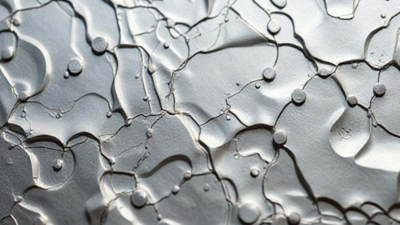
BENGALURU: A team of Indian researchers has developed a bioinspired aluminium surface with properties that could benefit industries ranging from marine engineering to food packaging and healthcare.
The findings, published in ‘Colloids and Surfaces B: Biointerfaces’, highlight how mimicking structures found in nature, such as lotus leaves and insect wings — can yield multifunctional surfaces that repel water, resist corrosion and bacteria, and clean themselves with minimal water.
Led by Harpreet S Grewal, the team from
Shiv Nadar University
in Delhi-NCR created micro-and-nanostructured aluminium surfaces using a low-cost and environmentally friendly process. The method, which involves imprinting aluminium sheets with micro-patterns and then immersing them in hot water, resulted in two distinct surfaces: “Nano” and “Hierarchy”.
These surfaces were then coated with a fluorinated silane compound to reduce surface energy and enhance water repellency. Tests showed that these treated surfaces could achieve extreme water-repelling (superhydrophobic) or water-attracting (superhydrophilic) states, depending on the treatment.
The “Nano” surface, for example, exhibited a contact angle of 163 degree, indicating water droplets roll off easily. Such characteristics are particularly useful in applications where cleanliness or moisture avoidance is crucial.
One key application explored was corrosion resistance in marine environments. When tested in saline conditions, the nanostructured surfaces showed significantly reduced corrosion current density, as much as 40 times lower than untreated aluminium, suggesting that these surfaces could extend the lifespan of metal components in seawater.
The researchers also evaluated self-cleaning and antibacterial properties. Surfaces with nanostructures required minimal water to remove chalk dust and resisted staining from common liquids like milk and coffee.
When exposed to E coli bacteria, the superhydrophilic nanostructured aluminium showed the greatest antibacterial effect, apparently due to the physical rupture of bacterial membranes upon contact with the densely packed nanoscale features.
“The dense nanoflakes act almost like a bed of spikes,” Grewal told TOI, explaining how the surface deforms and pierces bacterial cells, thereby reducing biofilm formation without the need for chemical disinfectants. Notably, the fabrication method avoids the use of hazardous chemicals and is designed to be scalable, an important consideration for industrial adoption.
“We’ve demonstrated a practical route to multifunctional aluminium surfaces using common materials and straightforward processing,” said co-author Priya Mandal. Beyond marine and food industries, such surfaces could be adapted for biomedical tools, electronics, or packaging materials where contamination control is critical.
Their work was supported by the Council of Scientific and Industrial Research (CSIR), India. Further development will focus on testing durability in real-world conditions and scaling up production for commercial use.

 1 month ago
157
1 month ago
157




























 English (US)
English (US)